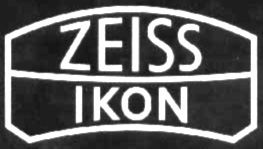

Zeiss has a tangled corporate history that rivals some American railroads. The main name bearer, Carl Zeiss, came from an optical firm called Carl Zeiss AG, which was founded around 1847 in Jena, Thuringia (now Germany). The company made optics for cameras, as well as microscopes, telescopes, and anything else that used lenses.
In the early twentieth century, German camera companies were undergoing a similar consolidation as was going on in America. In 1909, Hüttig AG, Kamerawerk Dr. Krügener, Wünsche and Carl Zeiss Palmos all merged to become a company called ICA. That organization, in 1926, merged with Ernemann, Goerz, and Contess-Nettel. The final result was a mixture of pieces and names: Zeiss/Ikon.
This multi-level merger gave Zeiss (for short) factories all over Germany and a presence in every major area of camera making. It was a double-edged sword: the good part was that it dominated the German industry, which in turn lead Europe and heavily influenced the rest of the world. The bad part was that Zeiss never organized themselves to decrease internal competition or streamline their operations. Zeiss catalogs pre-World War II were a laundry list of cameras with all sorts of configurations and options.
World War II, however, changed everything. Or rather Germany's loss of World War II changed everything. Germany ended up cleaved into two seperate sections: West Germany, occupied by Britain and France and the US, and East, occupied by the Soviet Union. The company, likewise, ended up functionally cut in half; factories in East Germany came under the domination of Russia; factories in the West under the western allies. Folklore has it that the top brass and engineers fled Eastern Germany as the Russians moved in, but the workers largely stayed. The late Herbert Keppler, editor/publisher of Modern Photography and Popular Photography, felt the split was more by line of business: the best of the optical people went West, but the best camera people stayed in the east.
Regardless, the result was two Zeiss companies. Most of Germany's patents ended up being invalidated due to the war, but their trademarks were bitterly fought over. The West German company eventually got the rights to use the name Zeiss, while the East Germans changed the name to Pentacon.
The Russians cleared out the East German factories and shipped them back to Russia as war reparations, and Zeiss there had to retool pretty much from scratch, while the Russians began building pre-war Zeiss designs under new Russian designations. Kepper thought the East German cameras that eventually emerged were far better than the West German counterparts; a mixture of talent and imagination plus the dubious advantage of having to start over from square one. East German optics, on the other hand, never really advanced; whereas the West German counterpart, now called Carl Zeiss, flourished.
The West German camera industry was rapidly overtaken by the Japanese. While many Zeiss cameras of the time were innovative, they were very expensive, complicated, and often quirky. Zeiss also acquired Voigtländer, which didn't exactly open up any new markets but added more duplication among their current lines. And of course they continued their pattern of selling several variations of the same camera with minor changes in each.
Unlike the Japanese, the Germans were reluctant to abandon the between-lens shutters for focal plane shutters, and thus had great difficulty keeping up with the Japanese in the growing and very-important 35mm SLR market; ultimately they were left in the dust. Zeiss tried to leapfrog the Japanese but failed, and eventually ended their camera-manufacturing lines. Voigtländer went to Franke & Heidecke (Rollei), which foundered a decade later.
The East German side ....
Zeiss continued on as manufacturer of precision optics and other optical applications, and is now re-emerging and rebranding products with the Zeiss/Ikon name.